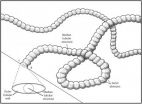(Press-News.org) RIVERSIDE, Calif. — Scientists at the University of California, Riverside have discovered a fossil of a newly discovered organism from the "Ediacara Biota" — a group of organisms that occurred in the Ediacaran period of geologic time.
Named Plexus ricei and resembling a curving tube, the organism resided on the Ediacaran seafloor. Plexus ricei individuals ranged in size from 5 to 80 centimeters long and 5 to 20 millimeters wide. Along with the rest of the Ediacara Biota, it evolved around 575 million years ago and disappeared from the fossil record around 540 million years ago, just around the time the Cambrian Explosion of evolutionary history was getting under way.
"Plexus was unlike any other fossil that we know from the Precambrian," said Mary L. Droser, a professor of paleontology, whose lab led the research. "It was bilaterally symmetrical at a time when bilaterians—all animals other than corals and sponges—were just appearing on this planet. It appears to have been very long and flat, much like a tapeworm or modern flatworm."
Study results appeared online last month in the Journal of Paleontology.
"Ediacaran fossils are extremely perplexing: they don't look like any animal that is alive today, and their interrelationships are very poorly understood," said Lucas V. Joel, a former graduate student at UC Riverside and the first author of the research paper. Joel worked in Droser's lab until June 2013.
He explained that during the Ediacaran there was no life on land. All life that we know about for the period was still in the oceans.
"Further, there was a complete lack of any bioturbation in the oceans at that time, meaning there were few marine organisms churning up marine sediments while looking for food," he said. "Then, starting in the Cambrian period, organisms began churning up and mixing the sediment."
According to the researchers, the lack of bioturbators during the Ediacaran allowed thick films of (probably) photosynthetic algal mats to accumulate on ocean floors—a very rare environment in the oceans today. Such an environment paved the way for many mat-related lifestyles to evolve, which become virtually absent in the post-Ediacaran world.
"The lack of bioturbation also created a very unique fossil preservational regime," Joel said. "When an organism died and was buried, it formed a mold of its body in the overlying sediment. As the organism decayed, sediment from beneath moved in to form a cast of the mold the organism had made in the sediment above. What this means is that the fossils we see in the field are not the exact fossils of the original organism, but instead molds and casts of its body."
Paleontologists have reported that much of the Ediacara Biota was comprised of tubular organisms. The question that Droser and Joel addressed was: Is Plexus ricei a tubular organism or is it an organism that wormed its way through the sand, leaving a trail behind it?
"In the Ediacaran we really need to know the difference between the fossils of actual tubular organisms and trace fossils because if the fossil we are looking at is a trace fossil, then that has huge implications for the earliest origins of bilaterian animals—organisms with bilateral symmetry up and down their midlines and that can move independently of environment forces," Joel said. "Being able to tell the difference between a tubular organism and a trace fossil has implications for the earliest origins of bilaterian organism, which are the only kinds of creatures that could have constructed a tubular trace fossil. Plexus is not a trace fossil. What our research shows is that the structure we see looks very much like a trace fossil, but is in fact a new Ediacaran tubular organism, Plexus ricei."
Plexus ricei was so named for plexus, meaning braided in Latin, a reference to the organism's morphology, and ricei for Rice, the last name of the South Australian Museum's Dennis Rice, one of the field assistants who helped excavate numerous specimens of the fossil.
"At this time, we don't know for sure that Plexus ricei was a bilateral but it is likely that it was related to our ancestors," Droser said.
INFORMATION:
She and Joel were joined in the research by James G. Gehling at the South Australian Museum. Joel is now a Ph.D. graduate student at the University of Michigan, Ann Arbor.
The research was funded by grants from the National Science Foundation and NASA to Droser; a National Science Foundation Graduate Research Fellowship to Joel; and a grant from the Australian Research Council to Gehling.
The University of California, Riverside is a doctoral research university, a living laboratory for groundbreaking exploration of issues critical to Inland Southern California, the state and communities around the world. Reflecting California's diverse culture, UCR's enrollment has exceeded 21,000 students. The campus opened a medical school in 2013 and has reached the heart of the Coachella Valley by way of the UCR Palm Desert Center. The campus has an annual statewide economic impact of more than $1 billion. A broadcast studio with fiber cable to the AT&T Hollywood hub is available for live or taped interviews. UCR also has ISDN for radio interviews. To learn more, call (951) UCR-NEWS.
Paleontologists discover new fossil organism
Likely related to our ancestors, 'Plexus ricei' was much like a tapeworm or modern flatworm, say UC Riverside researchers
2014-05-09
ELSE PRESS RELEASES FROM THIS DATE:
Discovery links rare, childhood neurodegenerative diseases to common problem in DNA repair
2014-05-09
(MEMPHIS, Tenn. – May 9, 2014) St. Jude Children's Research Hospital scientists studying two rare, inherited childhood neurodegenerative disorders have identified a new, possibly common source of DNA damage that may play a role in other neurodegenerative diseases, cancer and aging. The findings appear in the current issue of the scientific journal Nature Neuroscience.
Researchers showed for the first time that an enzyme required for normal DNA functioning causes DNA damage in the developing brain. DNA is the molecule found in nearly every cell that carries the instructions ...
Longevity gene may boost brain power
2014-05-09
Scientists showed that people who have a variant of a longevity gene, called KLOTHO, have improved brain skills such as thinking, learning and memory regardless of their age, sex, or whether they have a genetic risk factor for Alzheimer's disease. Increasing KLOTHO gene levels in mice made them smarter, possibly by increasing the strength of connections between nerve cells in the brain. The study was partly funded by the National Institutes of Health.
"This could be a major step toward helping millions around the world who are suffering from Alzheimer's disease and ...
Autism-related protein shown to play vital role in addiction
2014-05-09
BELMONT - In a paper published in the latest issue of the neuroscience journal Neuron, McLean Hospital investigators report that a gene essential for normal brain development, and previously linked to Autism Spectrum Disorders, also plays a critical role in addiction-related behaviors.
"In our lab, we investigate the brain mechanisms behind drug addiction – a common and devastating disease with limited treatment options," explained Christopher Cowan, PhD, director of the Integrated Neurobiology Laboratory at McLean and an associate professor of Psychiatry at Harvard Medical ...
Quick test can help spot depressed teenagers, UT Arlington nursing researcher finds
2014-05-09
A few minutes spent filling out a widely accepted mental health assessment in a health care provider's waiting room could make a big difference for some teenagers suffering from depression, according to new study from a nursing researcher at The University of Texas at Arlington.
Sharolyn Dihigo, a nurse practitioner and clinical assistant professor in the UT Arlington College of Nursing, recently examined available research to determine whether nurse practitioners and others in primary care settings should add a mental health screening to well visits for teenage patients. ...
Conducting polymer films decorated with biomolecules for cell research use
2014-05-09
The ability to create conducting polymer films in a variety of shapes, thicknesses and surface properties rapidly and inexpensively will make growing and testing cells easier and more flexible, according to a team of Penn State bioengineers.
"The ultimate goal of this collaborative project is to be able to create a substrate for growth and manipulation of cells," said Sheereen Majd, assistant professor of bioengineering. "Cells on a surface need to recognize biomolecules like extracellular matrix proteins to be able to adhere and grow. We ultimately would like to be able ...
Grape consumption may offer benefits for symptomatic knee osteoarthritis
2014-05-09
Fresno, CA – New research presented last week at the Experimental Biology conference in San Diego, California, suggests that regular grape consumption may help alleviate pain associated with symptomatic osteoarthritis of the knee, and improve joint flexibility and overall mobility. Researchers attribute these potential benefits to the polyphenols found in grapes.
The sixteen week clinical study, undertaken by Texas Woman's University, was designed to investigate the benefits of grape consumption on inflammation and osteoarthritis outcomes. 72 men and women with knee ...
Calcium supplements not associated with increased risk of cardiovascular disease in women
2014-05-09
Boston, MA – Calcium supplements are widely taken by women for bone health. Previous studies have suggested that calcium supplements may increase risk of cardiovascular disease, but the data has been inconsistent. A new study by researchers at Brigham and Women's Hospital (BWH) did not find that calcium supplement intake increases risk of cardiovascular disease in women.
The study is published online this month in Osteoporosis International.
Researchers examined supplemental calcium use and incident cardiovascular disease in a prospective cohort study of 74,245 women ...
Study validates air sampling techniques to fight bioterrorism
2014-05-09
ST. LOUIS – Air and surface sampling techniques currently used by the US government are effective in fighting bioterrorism and potentially saving lives, a Saint Louis University researcher finds.
Results published in Biosecurity and Bioterrorism by Alexander Garza, M.D., MPH, former chief medical officer at the Department of Homeland Security and a team of researchers from Los Alamos National Lab reviewed the data from a series of experiments simulating a bioterrorism attack against the Pentagon. Garza is now the associate dean for public health practice and associate ...
New species of metal-eating plant discovered in the Philippines
2014-05-09
Scientists from the University of the Philippines, Los Baños have discovered a new plant species with an unusual lifestyle — it eats nickel for a living — accumulating up to 18,000 ppm of the metal in its leaves without itself being poisoned, says Professor Edwino Fernando, lead author of the report. Such an amount is a hundred to a thousand times higher than in most other plants. The study was published in the open access journal PhytoKeys.
The new species is called Rinorea niccolifera, reflecting its ability to absorb nickel in very high amounts. Nickel hyperaccumulation ...
Plants' oil-desaturating enzymes pair up to channel metabolites
2014-05-09
UPTON, NY-Plant scientists at the U.S. Department of Energy's Brookhaven National Laboratory have found that certain enzymes responsible for desaturating fatty acids, the building blocks of oils, can link up to efficiently pass intermediate products from one enzyme to another. "Engineering these enzyme interactions to channel metabolites along desired metabolic pathways could be a new approach for tailoring plants to produce useful products," said Brookhaven biochemist John Shanklin, lead author on a paper reporting the results in the Journal of Biological Chemistry.
Getting ...
LAST 30 PRESS RELEASES:
Why nail-biting, procrastination and other self-sabotaging behaviors are rooted in survival instincts
Regional variations in mechanical properties of porcine leptomeninges
Artificial empathy in therapy and healthcare: advancements in interpersonal interaction technologies
Why some brains switch gears more efficiently than others
UVA’s Jundong Li wins ICDM’S 2025 Tao Li Award for data mining, machine learning
UVA’s low-power, high-performance computer power player Mircea Stan earns National Academy of Inventors fellowship
Not playing by the rules: USU researcher explores filamentous algae dynamics in rivers
Do our body clocks influence our risk of dementia?
Anthropologists offer new evidence of bipedalism in long-debated fossil discovery
Safer receipt paper from wood
Dosage-sensitive genes suggest no whole-genome duplications in ancestral angiosperm
First ancient human herpesvirus genomes document their deep history with humans
Why Some Bacteria Survive Antibiotics and How to Stop Them - New study reveals that bacteria can survive antibiotic treatment through two fundamentally different “shutdown modes”
UCLA study links scar healing to dangerous placenta condition
CHANGE-seq-BE finds off-target changes in the genome from base editors
The Journal of Nuclear Medicine Ahead-of-Print Tip Sheet: January 2, 2026
Delayed or absent first dose of measles, mumps, and rubella vaccination
Trends in US preterm birth rates by household income and race and ethnicity
Study identifies potential biomarker linked to progression and brain inflammation in multiple sclerosis
Many mothers in Norway do not show up for postnatal check-ups
Researchers want to find out why quick clay is so unstable
Superradiant spins show teamwork at the quantum scale
Cleveland Clinic Research links tumor bacteria to immunotherapy resistance in head and neck cancer
First Editorial of 2026: Resisting AI slop
Joint ground- and space-based observations reveal Saturn-mass rogue planet
Inheritable genetic variant offers protection against blood cancer risk and progression
Pigs settled Pacific islands alongside early human voyagers
A Coral reef’s daily pulse reshapes microbes in surrounding waters
EAST Tokamak experiments exceed plasma density limit, offering new approach to fusion ignition
Groundbreaking discovery reveals Africa’s oldest cremation pyre and complex ritual practices
[Press-News.org] Paleontologists discover new fossil organismLikely related to our ancestors, 'Plexus ricei' was much like a tapeworm or modern flatworm, say UC Riverside researchers





